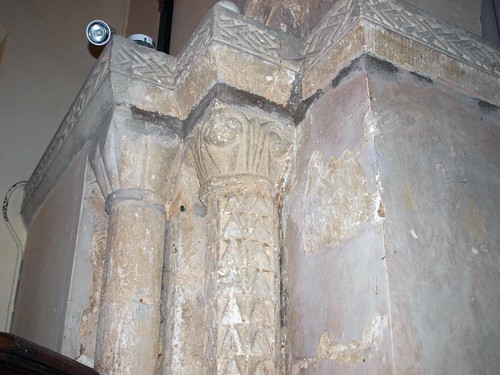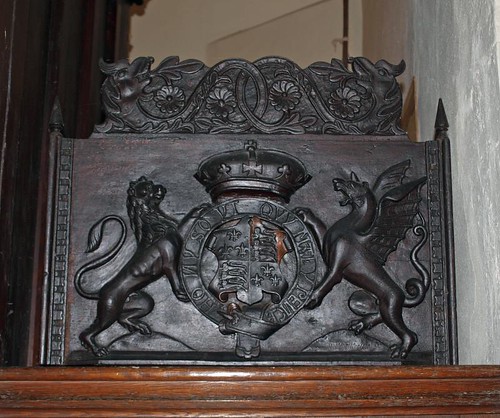The very drab exterior conceals a seriously exciting Norman carcass the first hint of which is the fantastic south door and inside the chancel arch is equally good. To the west of the arch is what appears to be an old doorway and in the nave are two similar recesses - purpose unknown.
The chancel has four good, modern, poppyheads, an elaborate ledger stone to Sire James Samson d.1349 and a wooden Bas relief Tudor coat of arms.
ALL SAINTS. Nave, chancel and belfry. The church was at the time of writing in a very neglected state. The S porch had fallen in and the spire was reduced to a timber skeleton. Yet the church is of some importance, especially for its Norman features. The S doorway has colonnettes with scalloped capitals and two orders of zigzag. The chancel arch has columns also. The inner order is of a remarkable design. Polygonal shafts decorated down each side by a chain of triangles. Another such column is now (re-used?) in a C13 recess at the E end of the S aisle. The capitals are scalloped or with volutes and slight leaf decoration. The chancel arch above the columns has decorated abaci. The arches are provided with a zigzag moulding and another with zigzags and a kind of stylized tongues lapping into them. In the nave N and S walls two identical C14 recesses on short triple shafts. - DOOR with traceried panels, C15; in a bad state. - STAINED GLASS E window, in the style of Warrington. - PAINTING. Annunciation, by a follower of Titian. A good picture, and ought to be looked after. - MONUMENT. Incised slab to James Samson, a priest d. 1349, 7 ft long. The style is Flemish rather than English, with an elaborate architectural surround, but the slab is of Purbeck marble, and we know too little of such pieces to decide against English authorship. The head of the figure unfortunately is renewed.
MIDDLETON. It clusters under a hill in the Gainsborough country, its small church with the rectory shaded by the fine beeches of the park. The 19th century spire, rising above the old timbered turret, looks down on the Norman walls of the chancel and the nave; we come into them through a doorway much as the Normans left it, with their round shafts, their zigzag on the arch, and their handsome capitals. Still swinging on its hinges is a door with the beautiful tracery of a medieval carpenter. There is a 16th century chest with quaint ironwork, and a painting of the Annunciation of the same age. In the floor of the chancel is a stone engraved with the portrait of James Samson, a rector of nearly 600 years ago, under a pinnacled canopy. The oak reredos is in memory of a rector who followed him after 500 years and stayed for over two generations. He came in 1823 and was rector till he died in 1889, aged 95. It is one of the most remarkable cases of long service we have come upon, for this rector, Oliver Raymond, followed his father Samuel who was rector for 54 years before him, so that father and son preached in this church for 120 years, through all the life of Napoleon and the French Revolution, through all the rise of modern England till after Queen Victoria’s Golden Jubilee.
Simon K -
Middleton, less than a mile to the south of Sudbury, was the scene of extraordinary events in the early 1930s. The Rector of the Anglican church in this parish of less than a hundred people, Father Clive Luget, reported a series of visions of the Blessed Virgin Mary.
An unmarried man, he arrived at Middleton from east London in 1931. On the evening of 11th December 1932, Luget witnessed the Crucifixion floating in light for five minutes above the graveyard, and the Blessed Virgin kneeling before it. Two days later, a seven year old boy called Francis Thornber had a vision of the church as it would have been in the Middle Ages. The Virgin Mary appeared to him, and gave him messages, but told him not to repeat them yet.
As the weeks went by, Luget and the Thornber boy had many more visions of the Virgin Mary. Sometimes the figure appears to be dazzling white, reported Luget. At other times, it is blue and about five feet six inches in height. The figure is of a young woman in a long flowing robe. Her hair is covered, but she has a most beautiful face. You cannot see her feet. With the appearance I had a distinct feeling of warm rays just as you feel when the sun strikes you.
The visions were publicised widely, and curious visitors flocked to Middleton. Luget hoped that the village would become the English Lourdes. He was probably partly motivated by the ghostly events attracting visitors to neighbouring Borley Rectory, a mile or so off, but also by the unprecedented success of Alfred Hope Patten's Marian shrine at Walsingham in Norfolk.
Luget's services became more and more extreme. He gave up all Anglican liturgies in favour of the Latin Mass, which was celebrated daily with clouds of incense. Congregations were rarely above 25 people, but hundreds of others would gather outside to see what would happen, including large crowds from the Ipswich-based Protestant Truth Society, who came to picket the Mass. Luget was reported to the Bishop of Chelmsford as a Papist.
By the late 1930s, Luget was seeing angels on a daily basis. As his parishioners and acolytes lost patience, the congregations gradually fell away, until no one came to the services anymore. Luget claimed to be receiving written messages from a medieval monk, Brother Bramarte, which he had found written in pencil on the wall of the Rectory cellar.
With the parish moribund, and the church falling into an advanced state of decay, the Bishop intervened. Luget was quietly retired, and died on the 28 April 1952 in hospital in Sudbury.
Today, no trace of Luget's incumbency at Middleton survives. No mention of him, or the extraordinary events of those times, is to be found in the church guide, which appears to have been written shortly after Luget's departure. The strangest memory the unsuspecting visitor will take away of the church will be the large, tame black swan which patrols the graveyard.
Flickr.
Simon K -
The Suffolk market town of Sudbury is bordered on two sides by the most intensely rural part of the neighbouring county of Essex. Here, remote from the bureacrats at County Hall in Chelmsford, the narrow lanes are unspoiled, the villages untouched. It is like stepping back in time.
An unmarried man, he arrived at Middleton from east London in 1931. On the evening of 11th December 1932, Luget witnessed the Crucifixion floating in light for five minutes above the graveyard, and the Blessed Virgin kneeling before it. Two days later, a seven year old boy called Francis Thornber had a vision of the church as it would have been in the Middle Ages. The Virgin Mary appeared to him, and gave him messages, but told him not to repeat them yet.
As the weeks went by, Luget and the Thornber boy had many more visions of the Virgin Mary. Sometimes the figure appears to be dazzling white, reported Luget. At other times, it is blue and about five feet six inches in height. The figure is of a young woman in a long flowing robe. Her hair is covered, but she has a most beautiful face. You cannot see her feet. With the appearance I had a distinct feeling of warm rays just as you feel when the sun strikes you.
The visions were publicised widely, and curious visitors flocked to Middleton. Luget hoped that the village would become the English Lourdes. He was probably partly motivated by the ghostly events attracting visitors to neighbouring Borley Rectory, a mile or so off, but also by the unprecedented success of Alfred Hope Patten's Marian shrine at Walsingham in Norfolk.
Luget's services became more and more extreme. He gave up all Anglican liturgies in favour of the Latin Mass, which was celebrated daily with clouds of incense. Congregations were rarely above 25 people, but hundreds of others would gather outside to see what would happen, including large crowds from the Ipswich-based Protestant Truth Society, who came to picket the Mass. Luget was reported to the Bishop of Chelmsford as a Papist.
Gradually, people lost interest, but Luget continued to have visions. Five clairvoyants saw Mary at the foot of the Cross in the Summer of 1933, and several extreme and bizarre people joined Luget's congregation. A hymn was written in honour of the visions. Luget obtained written statements from people who saw the visions, and were spoken to by the Blessed Virgin. Many were children, but one was a magistrate.
With the parish moribund, and the church falling into an advanced state of decay, the Bishop intervened. Luget was quietly retired, and died on the 28 April 1952 in hospital in Sudbury.
Today, no trace of Luget's incumbency at Middleton survives. No mention of him, or the extraordinary events of those times, is to be found in the church guide, which appears to have been written shortly after Luget's departure. The strangest memory the unsuspecting visitor will take away of the church will be the large, tame black swan which patrols the graveyard.
Flickr.




No comments:
Post a Comment